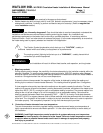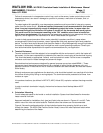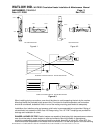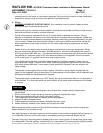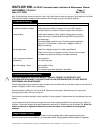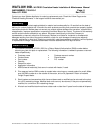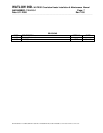WATLOW IND. WATROD
Circulation Heater Installation & Maintenance Manual
I&M NUMBER: 316-42-5-1 Page: 2
Date: 6/11/2008 Rev: 2.00
________________________________________________________________________________________________________________________________________________________________________________________________________________________
WATLOW IND.n # 6 INDUSTRIAL LOOP RD. n HANNIBAL MO, 63401n PHONE 573-221-2816 n FAX 573-221-3723
Failure of components in a temperature control loop, such as the sensor, heater control relay or main
temperature control, can result in damage to a product in process, a melt down of a heater, and / or
damaging fire.
To protect against this possibility, over temperature protection must be provided to interrupt or remove
power from the heater circuit. A bulb and capillary thermostat is not recommended for this function
since it may not respond quickly enough to adequately protect the heater. In cases where the
thermostat bulb gets too hot before the system is turned off, the thermostat bulb could rupture.
This could result in the thermostat remaining in the "ON" condition since there is insufficient
fluid to move contacts apart. We recommend the temperature protection have appropriate third party
approval, and be applied in the classification for which it was tested and approved.
In order to help prevent premature failure and a potentially hazardous condition in cases where
consequences of failure may be severe, use an appropriate third party approved liquid level protection
device. The liquid level should be such that the entire heater is fully submerged with enough liquid above
the heater to adequately dissipate heat from itself as under normal operating conditions. Consult your
local authorized sales representative for specific recommendations for your application.
3. Terminal Enclosures
Terminal enclosures should be selected to be compatible with the environment in which the heater will
be located. It is the users responsibility to determine the need for correct rating of the electrical housing.
This should be based on appropriate national and local electrical codes. Failure to use a compatible
enclosure could result in heater damage and personnel danger.
Standard terminal enclosures are designed for general purpose use and are rated NEMA 1. These
enclosures should be applied where there will be no danger of spilled liquids, dampness, dirt, and
gaseous conditions. Enclosures for wet or hazardous locations are also available, but must be installed
at the factory.
Although enclosures are supplied over the terminals, units should be located in an area that will minimize
the chance of being hit by falling or moving objects. The terminals must be protected at all times from
moisture or vapor.
In hazardous locations, (as defined in NFPA 70, NEC, Article 501) explosion resistant housings must be
used.
In order to maintain termination integrity, the terminal enclosure should be kept below 400°F
(204°C).
4. Orientation / Mounting
Furnish adequate space for horizontal or vertical installation. Space should be allowed for immersion
heater removal from tank.
Approved methods for installation of air (gas) and liquid units are shown in Figures # 1 and # 2. Take
careful note of the inlet and outlet locations. Positions other than shown are not recommended.
Figure # 3 shows the preferred position of the circulation heater when pumping liquid from a tank
through the heater. The NPSH (Net Positive Suction Head) is one of the most important factors when
determining the location of the heater.



